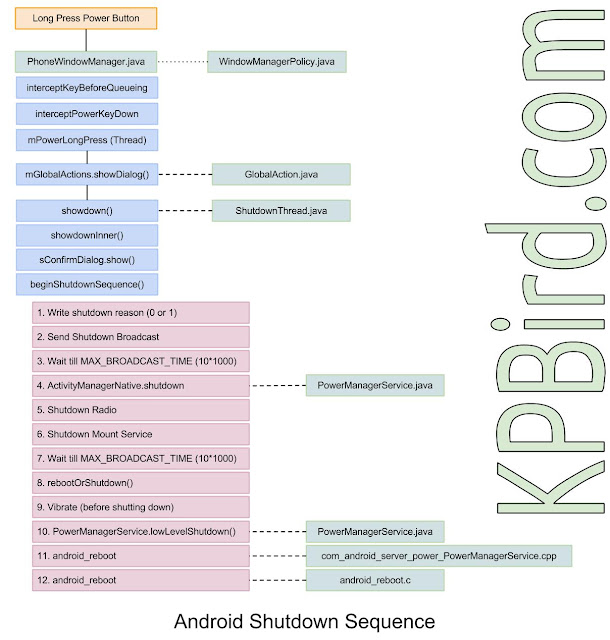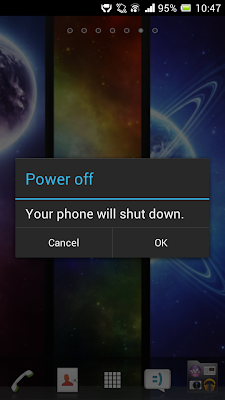In Depth : Android Shutdown Sequence
What happened when I long press power button ?
What is shutdown sequence ?
How is it different from desktop linux shutdown sequence?
How to change shutdown menu ?
Many questions pop-up in mind when we think about Android shutdown sequence. Before you read about shutdown sequence I suggest you to read aboutboot sequence article.
In this article I am going to explain shutdown sequence for Android only. Please refer"Linux Boot and Shutdown Process" for details of desktop linux shutdown process.
Following diagram illustrate shutdown sequence in detail.

- /** {@inheritDoc} */
- @Override
- public int interceptKeyBeforeQueueing(KeyEvent event, int policyFlags, boolean isScreenOn) {
- ....
- ....
- ....
- case KeyEvent.KEYCODE_POWER: {
- result &= ~ACTION_PASS_TO_USER;
- if (down) {
- if (isScreenOn && !mPowerKeyTriggered
- && (event.getFlags() & KeyEvent.FLAG_FALLBACK) == 0) {
- mPowerKeyTriggered = true;
- mPowerKeyTime = event.getDownTime();
- interceptScreenshotChord();
- }
- ITelephony telephonyService = getTelephonyService();
- boolean hungUp = false;
- if (telephonyService != null) {
- try {
- if (telephonyService.isRinging()) {
- // Pressing Power while there's a ringing incoming
- // call should silence the ringer.
- telephonyService.silenceRinger();
- } else if ((mIncallPowerBehavior
- & Settings.Secure.INCALL_POWER_BUTTON_BEHAVIOR_HANGUP) != 0
- && telephonyService.isOffhook()) {
- // Otherwise, if "Power button ends call" is enabled,
- // the Power button will hang up any current active call.
- hungUp = telephonyService.endCall();
- }
- } catch (RemoteException ex) {
- Log.w(TAG, "ITelephony threw RemoteException", ex);
- }
- }
- interceptPowerKeyDown(!isScreenOn || hungUp
- || mVolumeDownKeyTriggered || mVolumeUpKeyTriggered);
- } else {
- mPowerKeyTriggered = false;
- cancelPendingScreenshotChordAction();
- if (interceptPowerKeyUp(canceled || mPendingPowerKeyUpCanceled)) {
- result = (result & ~ACTION_WAKE_UP) | ACTION_GO_TO_SLEEP;
- }
- mPendingPowerKeyUpCanceled = false;
- }
- break;
- }
- ....
- ....
- ....
- }
- private void interceptPowerKeyDown(boolean handled) {
- mPowerKeyHandled = handled;
- if (!handled) {
- mHandler.postDelayed(mPowerLongPress, ViewConfiguration.getGlobalActionKeyTimeout());
- }
- }
Following code represent mPowerLongPress thread
- private final Runnable mPowerLongPress = new Runnable() {
- @Override
- public void run() {
- // The context isn't read
- if (mLongPressOnPowerBehavior < 0) {
- mLongPressOnPowerBehavior = mContext.getResources().getInteger(
- com.android.internal.R.integer.config_longPressOnPowerBehavior);
- }
- int resolvedBehavior = mLongPressOnPowerBehavior;
- if (FactoryTest.isLongPressOnPowerOffEnabled()) {
- resolvedBehavior = LONG_PRESS_POWER_SHUT_OFF_NO_CONFIRM;
- }
- switch (resolvedBehavior) {
- case LONG_PRESS_POWER_NOTHING:
- break;
- case LONG_PRESS_POWER_GLOBAL_ACTIONS:
- mPowerKeyHandled = true;
- if (!performHapticFeedbackLw(null, HapticFeedbackConstants.LONG_PRESS, false)) {
- performAuditoryFeedbackForAccessibilityIfNeed();
- }
- sendCloseSystemWindows(SYSTEM_DIALOG_REASON_GLOBAL_ACTIONS);
- showGlobalActionsDialog();
- break;
- case LONG_PRESS_POWER_SHUT_OFF:
- case LONG_PRESS_POWER_SHUT_OFF_NO_CONFIRM:
- mPowerKeyHandled = true;
- performHapticFeedbackLw(null, HapticFeedbackConstants.LONG_PRESS, false);
- sendCloseSystemWindows(SYSTEM_DIALOG_REASON_GLOBAL_ACTIONS);
- mWindowManagerFuncs.shutdown(resolvedBehavior == LONG_PRESS_POWER_SHUT_OFF);
- break;
- }
- }
- };
- void showGlobalActionsDialog() {
- if (mGlobalActions == null) {
- mGlobalActions = new GlobalActions(mContext, mWindowManagerFuncs);
- }
- final boolean keyguardShowing = keyguardIsShowingTq();
- mGlobalActions.showDialog(keyguardShowing, isDeviceProvisioned());
- if (keyguardShowing) {
- // since it took two seconds of long press to bring this up,
- // poke the wake lock so they have some time to see the dialog.
- mKeyguardMediator.userActivity();
- }
- }


- private static void beginShutdownSequence(Context context) {
- synchronized (sIsStartedGuard) {
- if (sIsStarted) {
- Log.d(TAG, "Shutdown sequence already running, returning.");
- return;
- }
- sIsStarted = true;
- }
- // throw up an indeterminate system dialog to indicate radio is
- // shutting down.
- ProgressDialog pd = new ProgressDialog(context);
- pd.setTitle(context.getText(com.android.internal.R.string.power_off));
- pd.setMessage(context.getText(com.android.internal.R.string.shutdown_progress));
- pd.setIndeterminate(true);
- pd.setCancelable(false);
- pd.getWindow().setType(WindowManager.LayoutParams.TYPE_KEYGUARD_DIALOG);
- pd.show();
- sInstance.mContext = context;
- sInstance.mPowerManager = (PowerManager)context.getSystemService(Context.POWER_SERVICE);
- // make sure we never fall asleep again
- sInstance.mCpuWakeLock = null;
- try {
- sInstance.mCpuWakeLock = sInstance.mPowerManager.newWakeLock(
- PowerManager.PARTIAL_WAKE_LOCK, TAG + "-cpu");
- sInstance.mCpuWakeLock.setReferenceCounted(false);
- sInstance.mCpuWakeLock.acquire();
- } catch (SecurityException e) {
- Log.w(TAG, "No permission to acquire wake lock", e);
- sInstance.mCpuWakeLock = null;
- }
- // also make sure the screen stays on for better user experience
- sInstance.mScreenWakeLock = null;
- if (sInstance.mPowerManager.isScreenOn()) {
- try {
- sInstance.mScreenWakeLock = sInstance.mPowerManager.newWakeLock(
- PowerManager.FULL_WAKE_LOCK, TAG + "-screen");
- sInstance.mScreenWakeLock.setReferenceCounted(false);
- sInstance.mScreenWakeLock.acquire();
- } catch (SecurityException e) {
- Log.w(TAG, "No permission to acquire wake lock", e);
- sInstance.mScreenWakeLock = null;
- }
- }
- // start the thread that initiates shutdown
- sInstance.mHandler = new Handler() {
- };
- sInstance.start();
- }
Run method, start actual shutdown process
- public void run() {
- BroadcastReceiver br = new BroadcastReceiver() {
- @Override public void onReceive(Context context, Intent intent) {
- // We don't allow apps to cancel this, so ignore the result.
- actionDone();
- }
- };
- /*
- * Write a system property in case the system_server reboots before we
- * get to the actual hardware restart. If that happens, we'll retry at
- * the beginning of the SystemServer startup.
- */
- {
- String reason = (mReboot ? "1" : "0") + (mRebootReason != null ? mRebootReason : "");
- SystemProperties.set(SHUTDOWN_ACTION_PROPERTY, reason);
- }
- /*
- * If we are rebooting into safe mode, write a system property
- * indicating so.
- */
- if (mRebootSafeMode) {
- SystemProperties.set(REBOOT_SAFEMODE_PROPERTY, "1");
- }
- Log.i(TAG, "Sending shutdown broadcast...");
- // First send the high-level shut down broadcast.
- mActionDone = false;
- Intent intent = new Intent(Intent.ACTION_SHUTDOWN);
- intent.addFlags(Intent.FLAG_RECEIVER_FOREGROUND);
- mContext.sendOrderedBroadcastAsUser(intent,
- UserHandle.ALL, null, br, mHandler, 0, null, null);
- final long endTime = SystemClock.elapsedRealtime() + MAX_BROADCAST_TIME;
- synchronized (mActionDoneSync) {
- while (!mActionDone) {
- long delay = endTime - SystemClock.elapsedRealtime();
- if (delay <= 0) {
- Log.w(TAG, "Shutdown broadcast timed out");
- break;
- }
- try {
- mActionDoneSync.wait(delay);
- } catch (InterruptedException e) {
- }
- }
- }
- Log.i(TAG, "Shutting down activity manager...");
- final IActivityManager am =
- ActivityManagerNative.asInterface(ServiceManager.checkService("activity"));
- if (am != null) {
- try {
- am.shutdown(MAX_BROADCAST_TIME);
- } catch (RemoteException e) {
- }
- }
- // Shutdown radios.
- shutdownRadios(MAX_RADIO_WAIT_TIME);
- // Shutdown MountService to ensure media is in a safe state
- IMountShutdownObserver observer = new IMountShutdownObserver.Stub() {
- public void onShutDownComplete(int statusCode) throws RemoteException {
- Log.w(TAG, "Result code " + statusCode + " from MountService.shutdown");
- actionDone();
- }
- };
- Log.i(TAG, "Shutting down MountService");
- // Set initial variables and time out time.
- mActionDone = false;
- final long endShutTime = SystemClock.elapsedRealtime() + MAX_SHUTDOWN_WAIT_TIME;
- synchronized (mActionDoneSync) {
- try {
- final IMountService mount = IMountService.Stub.asInterface(
- ServiceManager.checkService("mount"));
- if (mount != null) {
- mount.shutdown(observer);
- } else {
- Log.w(TAG, "MountService unavailable for shutdown");
- }
- } catch (Exception e) {
- Log.e(TAG, "Exception during MountService shutdown", e);
- }
- while (!mActionDone) {
- long delay = endShutTime - SystemClock.elapsedRealtime();
- if (delay <= 0) {
- Log.w(TAG, "Shutdown wait timed out");
- break;
- }
- try {
- mActionDoneSync.wait(delay);
- } catch (InterruptedException e) {
- }
- }
- }
- rebootOrShutdown(mReboot, mRebootReason);
- }
Step 7: With rebootOrShutdown() method controls transfer to the native function of com_android_server_power_PowerManagerService.cpp file, and finally control goes to android_reboot.c file which is final step of shutdown sequence.
- static void nativeShutdown(JNIEnv *env, jclass clazz) {
- android_reboot(ANDROID_RB_POWEROFF, 0, 0);
- }
In Depth : Android Shutdown Sequence的更多相关文章
- In Depth : Android Boot Sequence / Process
In Depth : Android Boot Sequence / Process What happened when I press power on button in my Android ...
- I.MX6 android shutdown 内核崩溃
/**************************************************************************** * I.MX6 android shutdo ...
- I.MX6 Android shutdown shell command
/******************************************************************************* * I.MX6 Android shu ...
- Android Framework层Power键关机流程(二,关机流程)
二,关机流程 从前一篇博文我们知道,当用户长按Power键时会弹出(关机.重启,飞行模式等选项)对话框,我们点击关机,则会弹出关机确认对话框.那么从选项对话框到关机确认对话框又是一个什么流程呢.下面我 ...
- Android关机流程源码分析
上一篇文章Android 开关机动画显示源码分析详细介绍了开关机动画的显示过程,Android系统开机时,在启动SurfaceFlinger服务过程中通过Android属性系统方式来启动bootani ...
- Android 4.1.2系统添加重启功能
对于Android的的手机或者平板长期使用,感觉会出现慢的情况,所以偶尔还是需要重启一下,而长按电源键弹出的菜单又没有重启选项,所以特在此记录自己添加这个功能的过程. 首先关机的那个弹出菜单是在fra ...
- 深入解析Android关机
下图详细阐释了Android的关机顺序. 第一步: 按住电源按钮半秒钟(500ms). 第二步: 之后,PhoneWindowManager.java 将捕获长按电源按钮这一事件并调用“interce ...
- Android 9.0 关机流程分析
极力推荐文章:欢迎收藏 Android 干货分享 阅读五分钟,每日十点,和您一起终身学习,这里是程序员Android 本篇文章主要介绍 Android 开发中的部分知识点,通过阅读本篇文章,您将收获以 ...
- No shutdown animation in the electricity display only 1%
低电量自动关机时无关机动画 低电量自动关机时无关机动画1. 问题描述2. 分析3. solution4. 总结 1. 问题描述 DEFECT DESCRIPTION: No shutdown anim ...
随机推荐
- X - A == B ?(第二季水)
Description Give you two numbers A and B, if A is equal to B, you should print "YES", or p ...
- MySQL 初学笔记 ② -- MySQL安装
1. Ubuntu安装 sudo apt-get install mysql-server //安装mysql服务 sudo apt-get install mysql-client // sudo ...
- 理解ThreadLocal(一)
早在JDK 1.2的版本中就提供java.lang.ThreadLocal,ThreadLocal为解决多线程程序的并发问题提供了一种新的思路.使用这个工具类可以很简洁地编写出优美的多线程程序. Th ...
- Samba服务器
Windows操作系统下:DOC命令下:netstat -an查看端口 (一)简介 文件服务器 (二)端口 smbd: 为clinet提高资源访问 tcp 139 445 (类似于windo ...
- Nginx 变量漫谈(六)
Nginx 内建变量用在“子请求”的上下文中时,其行为也会变得有些微妙. 前面在 (三) 中我们已经知道,许多内建变量都不是简单的“存放值的容器”,它们一般会通过注册“存取处理程序”来表现得与众不同, ...
- ASP.NET 短路由配置
1. 首先在项目新建文件叫App_Code或者App_Start 在文件中新建WebFromRouteHandler.cs 文件. WebFromRouteHandler中的代码如下, public ...
- sa命令从/var/account/pacct原始记账数据文件读取信息并汇总
sa命令从/var/account/pacct原始记账数据文件读取信息并汇总
- asp.net基础学习笔记
原文地址:http://blog.csdn.net/oxoxzhu/article/details/8652530 1.概论 浏览器-服务器 B/S 浏览的 浏览器和服务器之间的交互,形成上 ...
- Hadoop 3、Hadoop 分布式存储系统 HDFS
HDFS是Hadoop Distribute File System 的简称,也就是Hadoop的一个分布式文件系统. 一.HDFS的优缺点 1.HDFS优点: a.高容错性 .数据保存多个副本 .数 ...
- Hibernate问题之'hibernate.dialect' not set
继前文:Hibernate4中buildSessionFactory方法废弃问题.后 继续有问题.本来之前好好的项目,用了这种新的方法后发现问题. 出现 Connection cannot be n ...
